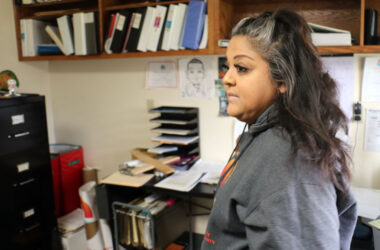 Psychic numbing, risk judgment and other concepts may explain why people seem to worry less as the pandemic grows and wears on. (CDC file art)
Psychic numbing, risk judgment and other concepts may explain why people seem to worry less as the pandemic grows and wears on. (CDC file art)
EUGENE – University of Oregon psychology professor Paul Slovic has spent much of his time during the COVID-19 pandemic writing articles, talking to journalists and thinking about why the coronavirus is so out of control.
To explain why case counts are surging and the virus is growing so rapidly, Slovic has drawn on previous psychological research that he thinks is relevant to the pandemic.
Slovic said there are a few concepts in particular — including reinforcement theory and psychic numbing — that can help everyone understand why, while the virus is getting worse, it seems the community is becoming less worried.
Fast and slow thinking
Slovic said that given the curve of coronavirus cases since March, it’s clear the growth is exponential. This means it is growing more rapidly over time. This type of growth happens when one person gets infected, then infects a couple others, who in turn each infect more than one person and so on.
“The human mind doesn’t deal with exponential growth very well,” Slovic said.
Behind this, he said, is psychological research that shows humans think in two ways: fast and slow. Fast thinking relies on intuition and gut feelings, while slow thinking is based on analysis, data and science.
“We rely on fast thinking because usually it works for us,” Slovic said. “It’s easy, it feels right and most of the time, it works for us. Except when it doesn’t. And when things are happening exponentially, it doesn’t work for us.”
Exponential coronavirus data can also teach us about climate change, Slovic said. The overwhelming surge of sea level rise will also come sooner than expected and the early exponential curve has been hard for the human brain to process.
If one isn’t trained to think exponentially or rely on slow thinking, they underestimate data. Slovic said the overwhelming surge that follows the initial, steadier exponential growth comes sooner than expected.
This is why we need to rely on scientists and experts — those who are trained to think slowly when they face data — to make decisions regarding the coronavirus, Slovic said.
“Listen to the experts,” he said. “Not the politicians.”
Risk judgment
Another reason people misjudge the risks of the coronavirus and allow it to get out of hand is because it’s an invisible threat. Unless people see the virus right in front of them — if they or a loved one gets sick — they don’t really think COVID-19 is there.
“We’re better at judging risk when we can see the evidence of it directly,” Slovic said.
Because people can’t see the virus itself, they are less likely to be careful about it and more likely to underestimate the risk of it, he said.
Reinforcement theory
Another factor that makes the virus hard to control is that everyone has to rely on behavior to curb the spread, Slovic said. Unfortunately, this means communities have to stop doing things they like and start doing things they don’t.
When the pandemic first hit the United States in the spring, most people followed guidelines and took them seriously, Slovic said. Because of pressure to open the economy — which resulted in relaxing restrictions — people started to relax and stop following guidelines as closely.
“Even now, when we have a tremendous amount of cases,” he said, “people are tired of doing the things they’re supposed to do.”
The reason people are tired of practicing COVID-19-safe behaviors is because they don’t feel the benefit from them, Slovic said. In fact, they feel like they’re being punished.
Slovic said people can understand these behaviors through reinforcement theory — a concept that students might have come across in an introductory psychology class.
Reinforcement schedules are rules that state the relationship between a behavior and its consequences. With COVID-19, the reinforcement schedules are the opposite of what they need to be to keep people doing the right thing, Slovic said. People don’t feel the immediate consequences when they do what’s wrong, and they feel punished for doing what’s right.
“You don’t see who you’ve been protected from or who you’ve been protecting. You don’t see the benefit,” he said. “But you feel the cost that you’re constrained and you can’t do the things you want to do.”
Slovic said those kinds of reinforcement schedules don’t keep people motivated to keep doing the right thing and continue following COVID-19 guidelines.
“So that’s why you see people who are really good people and are concerned about COVID in general. They relax their guard,” Slovic said. “And that’s inevitable.”
This backwards reinforcement schedule means that the only way to get people to do the right thing during the pandemic is to enforce regulations and shut things down.
Psychic numbing and feelings of inefficacy
Another psychological concept that explains why the virus is out of control is called psychic numbing. When people are exposed to countless data and statistics, they become numb to the information, Slovic said.
Especially as numbers increase, he said, they become just that — numbers. They don’t carry emotion and they don’t impact people as much.
A related concept is the feeling of inefficacy. Even if individuals are concerned about something, they feel as if they can’t do anything about it.
As Slovic put it: “Why make yourself miserable worrying about these horrible things if you feel you can’t do anything about it?”
An example of this occurred in a study regarding donating to children in need, Slovic said. Participants were shown two commercials: one of a single child they could donate to, and one of that same child next to statistics of millions of other children who needed aid.
Participants who saw the commercial with the statistics were almost 50% less likely to donate, even though the inclusion of the data was meant to get more donations.
This happened, Slovic said, because with the added millions of children, it felt like the problem was too big and a single donation wouldn’t help.
People feel this sense of inefficacy — often false inefficacy — because their feelings mislead them.
David Markowitz is a professor at UO’s School of Journalism and Communication. Markowitz and Slovic have collaborated on projects including exploring why people dehumanize immigrants in the United States.
Markowitz said he thinks psychic numbing is the most relevant concept on display during the pandemic.
“As the number of cases and deaths surge,” Markowitz said, “our feeling system becomes numb and cannot respond compassionately.”
Markowitz and Slovic agree that hearing stories about COVID-19 directly affecting people — instead of just seeing numbers and data — can make people care more about it.
The arithmetic of compassion
Slovic uses this term — the arithmetic of compassion — to explain why people care less when they should care more. Their feelings can only do arithmetic up to the number one, he said.
The arithmetic of compassion, Slovic said, is a mistake. In reality, people should care more about problems that are bigger. Everyone should work harder to stop them, he said, but they actually do less.
“The more who die,” Slovic said, “the less we care.”
Slovic said efficacy is a powerful motivator for people’s actions, and this also explains human behavior during the pandemic. Feelings of inefficacy can arise when people see others ignoring coronavirus guidelines or when they can’t help but be exposed to others at their jobs, for example.
“If we don’t think our actions make a difference and they’re not pleasant to do,” he said, “we won’t do them.”
In addition to working for the university, Slovic is the founder and president of Decision Research, an institute that investigates human judgment, decision-making and risk, according to its website.
Along with others from the institute and faculty from various universities including UO, Slovic has been working on a project titled the Arithmetic of Compassion.
Slovic said the project goes from the basic science of things like psychic numbing and inefficacy and shows how those concepts play out in the world around us. The goal of the project is to make people aware of this mistaken arithmetic and other psychological factors that affect their behavior.
Maybe, Slovic said, the project can help people overcome the barriers and get the arithmetic right.
This article is republished with permission from the Daily Emerald, an independent news operation produced by and for students at the University of Oregon. Reporter Sally Segar is a UO senior studying journalism and environmental studies.




